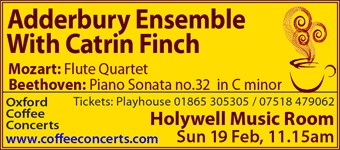Sunday saw an unusual coffee concert programme, with works ranging over 130 years and the presence of a harp, a very welcome addition to the venue repertoire. The opening Quartet in G for flute and strings by W.A. Mozart of 1777 was written for an amateur flautist, a ship's surgeon working for the Dutch East India Company. H. Robbins Landon, the musicologist specialising in Haydn and Mozart, opines that this quartet "fails to meet the high standards of its [flute quartet] predecessor, suggesting that Mozart was quickly bored by his task". It resembled something from the composer's juvenile output, I thought, being, in two movements only, though flautist Julian Sperry demonstrated his digital dexterity in the 'andante', while in the melancholy slow section the flute was supported by concerted plucking from violin, viola and cello.
A curiosity followed in the guise of Heinrich Baermann's Adagio from his Clarinet Concerto in E flat, just about the only work from him that anyone's heard of. It was a poignant little thing from one generation later than Mozart, though so brief that the introduction to it by clarinettist Fiona Cross lasted for almost as long as the piece itself. This was followed by something altogether meatier, a Fantaisie for violin and harp by Camille Saint-Saens. The line-up of musicians changed now for a second time, with violinist Jenny Sacha and harpist Catrin Finch combining for this work in seven brief parts. All our musicians were in dress code black, but Ms Finch added a dash of colour, welcome on a mild but grey morning, with her red, brass-studded shoes and black-and-gold harp.
Since hearing Saint-Saens' 5th (Egyptian) Piano Concerto recently at the Sheldonian, I've been playing at home all five of the piano concertos and other of his music, and the sniffy view of him in rarefied musical circles as an anachronistic tunesmith in an age of impressionism and the first stirrings of atonal music is surely deluded in its aesthetic isolationism. Ms Finch's harp was unusually assertive for this instrument in the lively three opening parts. There followed a charming moment when both players plucked in unison at their instruments. Then in the penultimate section, an 'ostinato', the harp took on almost a guitar-like sound, though deeper, as it repeated endlessly the same phrase. Her harp was a delight throughout, and it was a little downcasting to learn that there are no current plans to invite her back in the near future.
Finally we came to Ravel's Introduction and Allegro, written over eight days and three long nights in 1903 before Ravel joined friends on a yacht out of Biarritz, cruising the north coast of Spain. This was the most familiar element of the concert, forthwith striking a Debussyian note of impressionistic sound from the combination of flute, clarinet and harp. Could this music have been written without the pathfinding L'Apres-midi d'un Faune from nine years earlier? The initial stages are redolent of a summer afternoon spent sipping fruit cup under a parasol on a country lawn. Ms Finch then produced rather expansive, sinuous gestures as she wound out her cadenza, at last cut off by twittering flute and clarinet.




